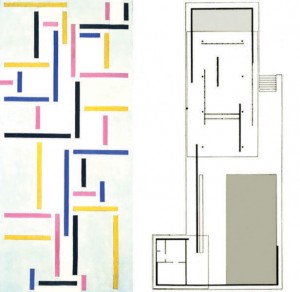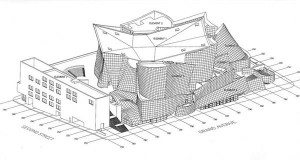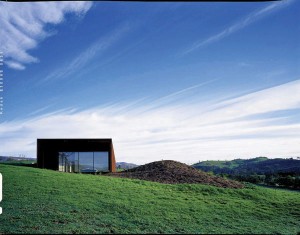-
The Art of Architecture
January 2010
By Amanda Rajakaruna
The best skill of an architect lies in the ability to creatively find a solution to a given building problem. The Architect then converts it into a form of imagery through a simple sketch on paper and from thereon transfers it into a model of a building.

ZAHA HADID : DUBAI OPERA HOUSE Gentle winding forms and peaks sculpturally depict the mountains and sand dunes of Dubai
 Architecture is a creative manipulation of mass, space and volume, enhanced and flavoured with textures, light and shadows and most importantly the functionality and practicality of cost and construction technology incorporated aesthetically. It can also occur where the form of the built space follows its intended function, representing a form derived by the solution to the design problem.
Architecture is a creative manipulation of mass, space and volume, enhanced and flavoured with textures, light and shadows and most importantly the functionality and practicality of cost and construction technology incorporated aesthetically. It can also occur where the form of the built space follows its intended function, representing a form derived by the solution to the design problem.
This artistic end result therefore is the key element of architecture, signifying that architecture is more than a functional composition of space and mass; an art in its self.
Architecture was considered along with music, sculpture, dance and painting
together in a mode referred to as art. Through the ancient cultures of the east and west including the Gothic, Renaissance and Baroque periods, both art and architecture have been a merged element throughout.
However with time and the rise of a merchant class in the 19th Century, the interdependency of these arts began to diminish and as a result separate due to the general fragmentation of society into competitive single units. The concept of ‘architecture’ was at times seen to be replaced with ‘building’, becoming purely economical.
However, it is their separation which has enabled them to also influence each other in ways never thought of before.
Then is architecture still the mother of all arts where “art” has stemmed from architecture or instead has ‘architecture’ stemmed from art, being a representation of art?
Music and dance are such forms of art. While for the dancer, choreography occurs through the unfolding of spatial dimensions through body movements and graceful gestures, to the architect, space is the medium through which forms emerge and a moulding of mass is constructed. The late Indian classical dancer, Balasaraswati once explained how she saw that the structure of the bharathanatyam repertoire captured the architecture and spirit of the Hindu Gopuram. Similar to a music composition, great architecture always has a beginning, a middle and an end, a series of events resulting in very strong climaxes and a toning down into anticlimaxes. Johann Wolfgang von Goethe suggests that architecture is “frozen music”, with special reference to Baroque architecture, indicating a graceful and free flowing form, almost intangible.
Is architecture therefore really frozen as implied or is it more dynamic evoking reactive changes within the user?
In the past, a distinct difference existed between that of art and architecture. They were two very different elements which were never considered to be linked or even related to each other. Art forms such as painting and sculpture were in fact used purely to ornament a building like that of the sculptures in Greek and Roman architecture.
However, from the end of the 19th century, the distinction between the spheres of architecture and sculpture became increasingly blurred, beginning to morph together. For instance, how should the Eiffel Tower be regarded? Is it a work of architecture serving no purpose other than for tourism? Or is it an immense, ‘inhabitable’ sculpture?

FRANK GEHRY: WALT DISNEY CONCERT HALL The entrance into the concert hall depicting the space created between two sails
Although different in architectural styles and language, through their sculptural approach to architecture, architects such as Herzog and De Meuron, Daniel Lebeskind, Frank Ghery, Zaha Hadid, Renzo Piano, along with Mies Van der Rohe, Tadao Ando, Sean Godsell, prove that architecture is indeed an art. It is truly admirable how they decipher the design problem in a creative manner resulting in a form so artistic and so sculptural that it is viewed as a work of art. As “conceptual artists” these architects are successful in capturing the concept of the building and comprehending what it stems from, in turn creating architecture that does not detach itself from its initial idea. What is most fascinating is how they have retained this conceptual imagery from beginning to end, presenting a functional building.
Fondly referred to as the “crazy lady with the Pritzker Prize-winning architectural madness” architect ZahaHadid is one of the most important contemporary exponents of sculptural architecture. This term “sculptural architecture” is most often applied to asymmetrical, freestanding, and labyrinthine structures whose plan and layout cannot be reconstructed from a single frontal viewpoint. Instead, the viewer has to walk around the building to absorb it and truly comprehend it.
The concept of “Deconstructivism” is creating an embedded impact in today’s architecture.
The Dubai Opera House (begun in 2006) with its gentle winding forms and peaks sculpturally depicts the mountains and sand dunes of Dubai. It is designed in order that the main building seems to rise off the ground becoming an element in the sky with the surrounding landscapes building up to it. Although it looks purely sculptural and is presented as a monumental building, it houses an auditorium which seats 2,500 people, a 5000 square metre art gallery, an 800-seat playhouse, a performing arts school and a hotel, portraying a successful and challengingly functional building.

MIES VAN DER ROHE: FARNSWORTH HOUSE & BARCELONA PAVILION - The Barcelona Pavilion with its simple composition of lines shows resemblance to a painting by Theo Van Doesburg
Moving away from the constricting “rules” of modernism such as “form follows function”, “purity of form” and “truth to materials” the concept of “Deconstructivism” is creating an embedded impact in today’s architecture. Ideas of fragmentation, manipulative structural surface, non rectilinear shapes which tend to distort and dislocate, result in a style that is stimulatingly unpredictable and in turn is a successfully controlled sense of chaos.
Architect Frank Gehry, most famous for using unorthodox materials such as corrugated metal and chain link and whose work has been described as radical, playful, organic and almost sensual says, “I approach each building as a sculptural object, a spatial container, a space with light and air, a response to context and appropriateness of feeling and spirit. To this container, this sculpture, the user brings his baggage, his programme and interacts with it to accommodate his needs. If he can’t do that, I’ve failed.”
The Walt Disney concert Hall in Los Angeles, USA by Frank Gehry, which took 16 years to complete, challengingly required a box like interior due to the demand of solid acoustic needs. Yet instead of creating a box like form which represented its function, Gehry breaks away from the function visually, explaining that the best feeling one experiences is directly behind a sail as the wind blows around its edges. He thus portrays large sails, where corners are instead suppressed, walls, floors and ceilings curved and swelled; carrying, reflecting and fanning sound. It is designed in order that the eye roams around the space in continuous movement.
Arguably, does this imply that architecture should be organic in order to be represented as art? Or does architecture carrying straight lines and geometric forms also fall into the category of being sculptural?
For instance, architect Sean Godsell’s style of architecture is that of simplicity, where he presents straightforward, uncomplicated forms which the eye captures as a complete object; an element; a sculpture. “The Glenburn house”, conceptually is the relationship between a ship and the water and is presented through a simple form, where the rectilinear element is presented as the ship enveloped by the earth.
Both “The Barcelona pavilion” and the “Farnsworth House” by Mies van der Rohe are great examples of a simple geometric form visualised sculpturally. Here while the eye captures the built form as a whole, the spaces within merge together freely, non dictative. It is interesting to note the resemblance the pavilion has with a painting by Theo Van Doesburg, where a series of straight lines composed together form a work or art, be it two dimensionally or three dimensionally.
This then represents that architecture can be artistic through a simple form or one of organic complexity.
Architecture therefore does not limit to being a purely functional response to a problem based on a clients brief but is an artistic approach which clearly brings out the “artist” within the architect.















